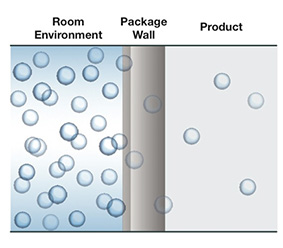The Importance of Permeability in Modified Atmosphere Packaging

Molecules permeate through the package wall into the package
Packaging products in a modified atmosphere can significantly improve the shelf life of the product, but it is vital that the right packaging material (also called “the barrier”) is selected for the particular product and for the gas mixture that is being used.
Package designers must tread a careful line between over-packaging, which is wasteful, costly and detrimental to the environment, and under-packaging, which can result in reduced shelf life and more returns, incurring expense.
In modified atmosphere packaging (MAP), a key factor in the choice of the barrier material is the rate at which gases can pass through it – its permeability. There is a wide range of barrier material, with different materials having different permeability properties.
Protecting a product through packaging aims at both reducing the possibility of physical damage, and also to provide a chemical safeguard. While protection of the product from physical damage is always a factor, chemical protection must also be considered. Microbiological contamination, oxidation, rancidity, loss of moisture, component degradation, flavour loss, off-flavour, and loss of carbonation are just some examples of the chemical damage that can be caused without appropriate packaging. Permeability measurements are key in defining the appropriate package to help minimise or control this damage.
Many products such as foods can deteriorate if they are exposed to oxygen, for example. In many modified atmosphere packaging processes, most of the oxygen is flushed out of the package and replaced by gases such as nitrogen or carbon dioxide. In such cases it is necessary to know the packaging material’s permeability to both the gases that one wishes to remain in the package and those that one wishes to keep out. For this reason, it is important to obtain data on the permeability of the packaging barrier to the relevant gases.
Once a suitable packaging barrier has been selected based on the supplier’s permeability data, the MAP gases to be used and the product, producers usually carry out shelf life tests to ensure that the packaging meets the required specifications.
Ultimately, the correct packaging barrier permeability together with the appropriate modified atmosphere will result in the most economical and efficient packaging outcome and will meet the specified shelf life requirements.
Further information about permeability www.mocon.com




